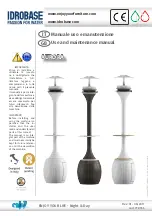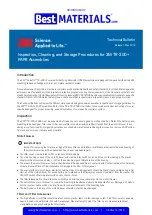
5
6
SPECIFICATIONS
W
WARNING
Failure to follow these instructions may reduce respirator performance, overexpose you to contaminants, and
may result
in sickness or death.
• To meet the NIOSH requirement 42 CFR 84, Subpart 84.150 for minimum and maximum airfl ow (4 to 15 cfm, 113 to
425 lpm), the air control valves approved for use with the 3M™ Dual Airline Respirators must be operated within the
supply pressure ranges and hose lengths stated in the
Air Supply Requirements
table in these
User Instructions
.
• You must comply with Occupational Safety and Health Administration (OSHA) standard 29 CFR 1910.134, which states
that, “Airline couplings shall be incompatible with outlets for other gas systems to prevent inadvertent servicing of
airline respirators with nonrespirable gases or oxygen”. In Canada, refer to CSA standard Z180.1 or the requirements
of the authority having jurisdiction in your region.
• Your employer must provide compressed breathing air that meets at least the requirements of the specifi cation for
Grade D breathing air, as described in the Compressed Gas Association Commodity Specifi cation G-7.1 in the United
States. In Canada, refer to CSA standard Z180.1 table for the quality of compressed breathing air.
• The line pressure must be kept within safe limits, 125 psig (8.75 kg/cm
2
) maximum. Dirt, oil and water, unless trapped
or fi ltered out, may continue downstream in concentrated form and adversely affect the performance of the respirator.
Discussion on Respirable Air
Many older compressed air systems may have air that is unfi t for human use without secondary air treatment. This is due largely
to the presence of objectionable oil vapors and odors. Rules and regulations governing air quality when using compressed air for
respiration are quite specifi c. Precautions must be observed when using compressed air for breathing purposes.
From Compressor
Shut-off Valve
Pressure Gauge
Pressure Relief Valve
Check Valve
Pressure Regulator
Hose
Small Particle Airline Filter
Fig. 1
Oil mist from the compressor lubricating oil must not be present when the air reaches the air control device. Excessive
amounts of water vapor and any particulate matter should also be removed as they may result in unpredictable behavior of
the air control device. The schematic diagram (Fig. 1) of the air purifi er and pressure regulator equipment shows what should
be installed in the main airline ahead of the connection for breathing air hoses.
If a pre-assembled air fi ltering and regulating device is desired, 3M offers several compressed air fi lter and regulator panel
assemblies. These assemblies contain a specially designed fi lter cartridge to help remove oil mist and vapors, condensed
moisture, particulates, odors and vapors. They come completely assembled and are ready for connection between the
compressor or compressed air bottle and the supplied air respirator system.
NOTE:
Use of these devices does not ensure the
delivery of Grade D breathable air.
NOTE: Carbon monoxide
Although it is theoretically possible that oil lubricated compressors can create carbon monoxide (CO) if the compressor
overheats, studies have shown that the location of the compressor’s air intake is the most likely source of carbon
monoxide contamination
1
. According to OSHA regulation [29 CFR (1910.134)(i)], periodic CO monitoring, rather than
continuous CO monitoring with an alarm, is acceptable if the oil lubricated compressor is equipped with a high
temperature alarm and automatic shut-down. In Canada, follow CSA standard Z94.4 or the requirements of the authority
having jurisdiction in your region.
1
Formation of carbon monoxide in air compressors, Am. Ind. Hyg. Assoc. J (40), June 1979, pp. 548-551.
SYSTEM COMPONENTS AND REPLACEMENT PARTS
This section serves as an illustration of the major components of the 3M™ Dual Airline Systems, not including the half or full
facepiece respirator. A descriptive listing of the individual components is found later in this section.
SA-1115
SA-2500
SA-2600
SA-1500
SA-1600
GVP-127
SA-1009
SA-1029
6880


































